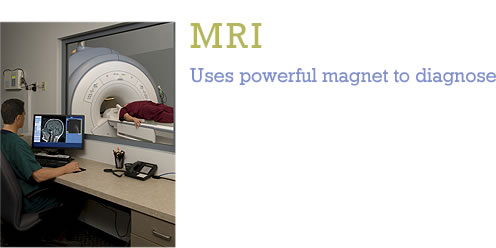Health Tips - MRI

Magnetic resonance imaging (MRI) creates detailed pictures of the internal structures of the body. Resonance is the tendency of something to vibrate when stimulated.
To take an MRI image, a patient lies on a bed, which moves into the central tube of an MRI scanner. Once inside the machine, it is turned on, using a very powerful magnet and pulsing radio waves to temporarily alter the water molecules in the patient’s body. The machine detects that reaction and the information is sent to a computer, which creates an image of the inner body.
An injection of contrast “dye” may be used to help visualize tissues in the body. Concerning the safety of the contrast ingredient, gadolinium, it is considered safe in the form it is used for MRI’s. Patients with kidney problems should research the use of gadolinium before an MRI, or ask a kidney specialist.
Pros
An MRI scan provides valuable information about the condition of glands, organs, nerves, muscles, and other tissues in the body. It is very useful for evaluating the heart and arteries, where it can detect blood clots, aneurysms, etc. An MRI can evaluate the integrity of the spinal cord after trauma. As bones have almost no water to respond, they are not ideally viewed by an MRI. MRI scans are best suited for viewing soft tissue.
Surgery can often be put off or more accurately directed after knowing MRI results. More data helps people make better decisions about what to do!
Cons
The cost of an MRI ranges from $400 to $4000. The time taken for a complete MRI scan is at least 30 minutes, which can be difficult for some patients due to the close quarters of the tunnel.
Before an MRI, patients are required to remove all metallic objects. If a patient has certain metallic objects or implants inside their body, they generally cannot have an MRI. Specific metals can be attracted to the center of the magnet in the scanner, causing the metals to be pulled out of the patient’s body, resulting in injury or death.
The very high strength of the magnetic field needed to produce the scans is frequently up to 60,000 times the Earth's own magnetic field effects. The water molecules in a patient’s body are manipulated for about half an hour. In my patients, I find that the electromagnetic flows of the body become confused after an MRI and require straightening out for the body to feel and operate normally.
Are you, or is someone you know, about to have an MRI? Read my tip on hospital tests to find out how to prepare your body to handle it better.
All in all, this is a miraculous form of testing but does require caution before using. If you, or someone you know, is trying to solve a health problem, read success stories from patients to see if your condition might have a natural solution. Or, set up a phone consultation with me to discuss the safest, most natural options you have.
Dr. Pepi
September 17, 2010
